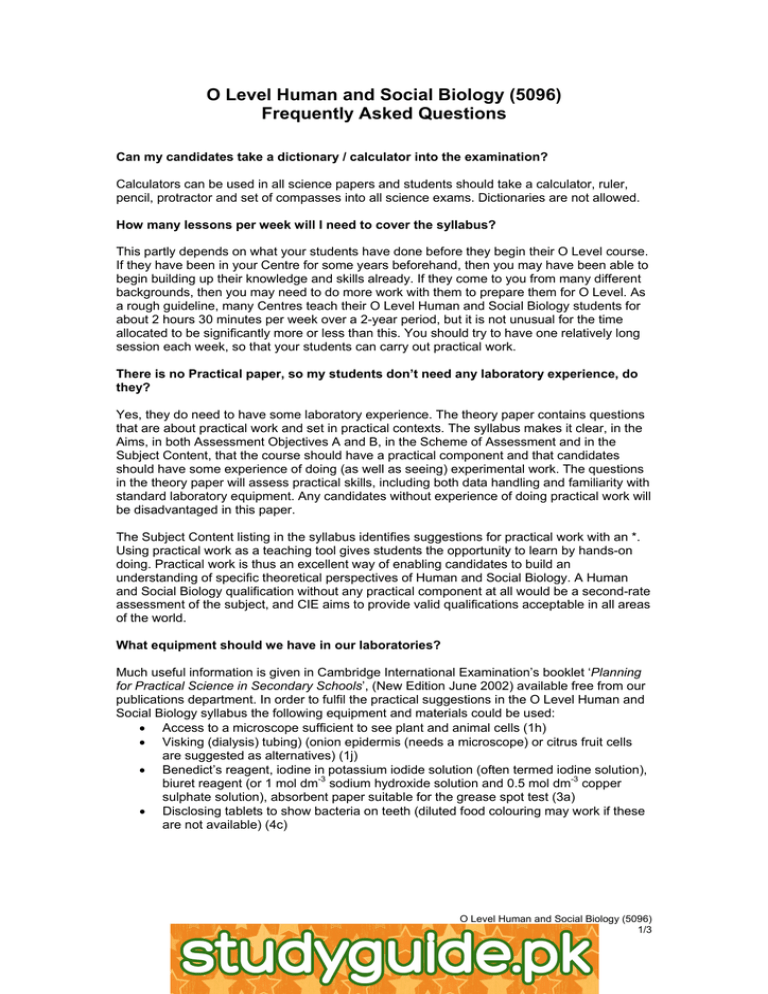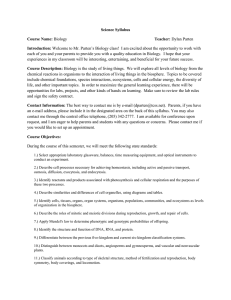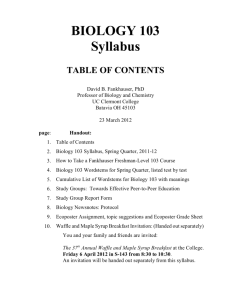O Level Human and Social Biology (5096) Frequently Asked Questions
advertisement

O Level Human and Social Biology (5096) Frequently Asked Questions Can my candidates take a dictionary / calculator into the examination? Calculators can be used in all science papers and students should take a calculator, ruler, pencil, protractor and set of compasses into all science exams. Dictionaries are not allowed. How many lessons per week will I need to cover the syllabus? This partly depends on what your students have done before they begin their O Level course. If they have been in your Centre for some years beforehand, then you may have been able to begin building up their knowledge and skills already. If they come to you from many different backgrounds, then you may need to do more work with them to prepare them for O Level. As a rough guideline, many Centres teach their O Level Human and Social Biology students for about 2 hours 30 minutes per week over a 2-year period, but it is not unusual for the time allocated to be significantly more or less than this. You should try to have one relatively long session each week, so that your students can carry out practical work. There is no Practical paper, so my students don’t need any laboratory experience, do they? Yes, they do need to have some laboratory experience. The theory paper contains questions that are about practical work and set in practical contexts. The syllabus makes it clear, in the Aims, in both Assessment Objectives A and B, in the Scheme of Assessment and in the Subject Content, that the course should have a practical component and that candidates should have some experience of doing (as well as seeing) experimental work. The questions in the theory paper will assess practical skills, including both data handling and familiarity with standard laboratory equipment. Any candidates without experience of doing practical work will be disadvantaged in this paper. The Subject Content listing in the syllabus identifies suggestions for practical work with an *. Using practical work as a teaching tool gives students the opportunity to learn by hands-on doing. Practical work is thus an excellent way of enabling candidates to build an understanding of specific theoretical perspectives of Human and Social Biology. A Human and Social Biology qualification without any practical component at all would be a second-rate assessment of the subject, and CIE aims to provide valid qualifications acceptable in all areas of the world. What equipment should we have in our laboratories? Much useful information is given in Cambridge International Examination’s booklet ‘Planning for Practical Science in Secondary Schools’, (New Edition June 2002) available free from our publications department. In order to fulfil the practical suggestions in the O Level Human and Social Biology syllabus the following equipment and materials could be used: • Access to a microscope sufficient to see plant and animal cells (1h) • Visking (dialysis) tubing) (onion epidermis (needs a microscope) or citrus fruit cells are suggested as alternatives) (1j) • Benedict’s reagent, iodine in potassium iodide solution (often termed iodine solution), -3 -3 biuret reagent (or 1 mol dm sodium hydroxide solution and 0.5 mol dm copper sulphate solution), absorbent paper suitable for the grease spot test (3a) • Disclosing tablets to show bacteria on teeth (diluted food colouring may work if these are not available) (4c) O Level Human and Social Biology (5096) 1/3 http://www.xtremepapers.net • • • • • • • • • • Amylase enzyme (diastase will work well and is cheap), starch suspension (made fresh by boiling starch in water and filtering to remove starch grains), iodine solution (see above), source of heat (e.g. Bunsen burner or gas ring or hot plate), 1mol dm-3 sodium hydroxide solution and 1 mol dm -3 hydrochloric acid solution (to be added 1 drop at a time to change pH), universal indicator paper or liquid with colour chart to measure pH (4e) Lime water or bicarbonate indicator (6f) Large bowl of water, smaller bowl and plastic tube (6g) Filter pump to connect to tap, to draw on lit cigarette, cotton wool to absorb tar, universal indicator paper or liquid to measure pH (6q) Human skeleton or model of skeleton; human, animal or model joint (articulated skeleton hanging from a hook is best, but a bag of bones is useful) (7g) Sharp knife to cut up kidney (8b) cow, sheep or goat eye (9c) Piece of board with pins stuck in it, so the pin heads (blunt end) can be gently rested on skin (9b) Long (metre) ruler for dropping for reaction time testing (9n) Glass or plastic Petri dishes (or other jars with lids), nutrient agar, safe place for incubation (room temperature in tropical regions, 25ºC in temperate regions), sources of safe water and food that contain some bacteria and fungi, disinfectant (12d) Specimens of anopheles mosquito and housefly (all stages of life cycle in both cases), e.g. mounted on microscope slides or embedded in plastic blocks (12k) What help and advice can you give me about health and safety in the laboratory? The most important point of first contact is with the organisation responsible for health and safety in schools locally; they must be consulted if you are in any doubt and will advise on any local legal requirements. In addition, there are several useful guides available and many are listed in the booklet ‘Planning Science in Secondary Schools’. Most chemical suppliers’ catalogues have details of safety requirements for specific chemicals, and ‘Hazards’ (published by CLEAPSS Development Group, Brunel University, Uxbridge) and ‘Hazard Data Sheets’ (published by BDH Laboratory Supplies) are excellent reference points. An on-line resource is located at www.labsafety.org. Which is the correct textbook for the course? We don’t require Centres to use any one particular textbook for our courses, and we would hope that wherever possible teachers would make use of a variety of different resources. It is good practice for students to get into the habit of using more than one book, and this also has the advantage that if they do not understand an explanation in one book, they may find a different explanation more helpful to them. We do provide a list of books in the syllabus that we believe teachers may find helpful, some of which were written specifically to cover the O Level Human and Social Biology syllabus. You can also find this on our website at www.cie.org.uk. (You will need to click on ‘Qualifications and Awards’, ‘O Level’ button and ‘Human and Social Biology’ then follow the instructions to locate the resource list.) Do I need to teach the course in the order given in the syllabus? No, the order in which you teach the course is entirely up to you. The curriculum content within the syllabus outlines the facts and concepts that will be assessed in the examination, but teachers are expected to construct and follow their own scheme of work based on the curriculum content. O Level Human and Social Biology (5096) 2/3 Where can I find information about the terminology and units used in this syllabus? The Institute of Biology publishes an excellent booklet entitled Biological Nomenclature – Standard terms and expressions used in the teaching of Biology. This is now in its third edition. Cambridge International Examinations follow the recommendations in this booklet when setting examination papers. You will find it an essential reference, containing guidance on best practice in recording results and graph construction, advice on how to represent genetic crosses etc. It can be obtained directly from the Institute of Biology, 20 Queensberry Place, London, SW7 2DZ, England. Alternatively, you can order a copy from the Institute of Biology's website at www.iob.org Where can I get advice from fellow teachers? There is a teacher discussion group for teachers of Biology, which Human and Social Biology teachers may find useful. It is hosted by the product manager at CIE with a senior examiner. To subscribe or unsubscribe via the World Wide Web, visit the Teacher Support Site. O Level Human and Social Biology (5096) 3/3





